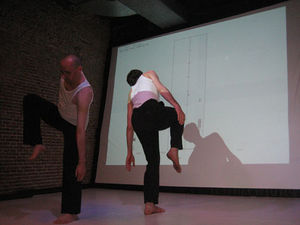Notations under provisions: Difference between revisions
No edit summary |
m (Text replacement - "{{Work" to "{{Graduation work") |
||
| (One intermediate revision by one other user not shown) | |||
| Line 1: | Line 1: | ||
{{ | {{Graduation work | ||
|Creator=Maria Karagianni, | |Creator=Maria Karagianni, | ||
|Date=2008 | |Date=2008 | ||
| Line 6: | Line 6: | ||
}} | }} | ||
http://pzwart3.wdka.hro.nl/video/NotationsUnderProvisions_WORM.webm | |||
Dance notations systems (only few universally established ones), as much as video recordings can be used for claiming authorship of a choreography.This dance performance is more a project investigating authorship in dance than a fixed dance piece. | Dance notations systems (only few universally established ones), as much as video recordings can be used for claiming authorship of a choreography.This dance performance is more a project investigating authorship in dance than a fixed dance piece. | ||
Latest revision as of 18:00, 31 March 2015
| Notations under provisions | |
|---|---|
| Creator | Maria Karagianni, |
| Year | 2008 |
| Bio | |
| Thumbnail | |
| Website | http://pzwart2.wdka.hro.nl/~mkaragianni/dasdance/ |
http://pzwart3.wdka.hro.nl/video/NotationsUnderProvisions_WORM.webm
Dance notations systems (only few universally established ones), as much as video recordings can be used for claiming authorship of a choreography.This dance performance is more a project investigating authorship in dance than a fixed dance piece.
The computer interface is the medium through which the audience can compose their own choreographies by using the keyboard during the performance. The computer programme is based on the system of Laban Rudolf for analyzing movements (which is the only 'open source' system that can be used without special permissions). An audience member, by typing their name and answer a question in the beginning of his/her typing, can choose whether to keep all the rights of the dance notation reserved or release them to the public domain. The 2 dancers correspond and execute the instructions given by the audience members through the computer. The pages of the notation are printed at the end of each choreographic session. Several audience members can take the turn to choreograph during one performance.
- http://www.opendans.nl/programma/2-voorstellingen/37-maria-karagianni-notations-under-provisions
- http://pzwart2.wdka.hro.nl/~mkaragianni/dasdance/



